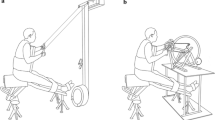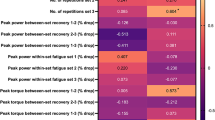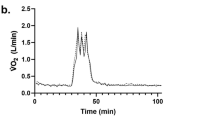Abstract
Resting energy expenditure, peak oxygen uptake (V˙O2peak) and the gas-exchange anaerobic threshold (Than) were measured during incremental arm cranking (15 W · min−1) in six able-bodied (AB) and six paraplegic (P) subjects. Only male subjects with traumatic spinal cord injuries in the area of the 10–12th thoracic segment were included in the P group. All AB and P subjects were physically active. Mean (SE) values for age and body mass were 28 (2) years and 78.9 (3.9) kg for the AB group and 32 (4) years and 70.8 (7.9) kg for the P group (P > 0.05). Resting energy expenditure values were not found to be significantly different between AB [5.8 (0.2) kJ · min−1] and P [5.1 (0.3) kJ · min−1] subjects. Mean V˙O2peak values were 29.3 (2.4) ml · kg−1 · min−1 and 29.6 (2.2) ml · kg−1 · min−1 for the AB and P groups, respectively (P > 0.05). Absolute oxygen uptake values measured at two gas-exchange anaerobic threshold (Than) were not significantly different between the two groups. However, the Than occurred at a significantly higher percentage of V˙O2peak in the P [58.9 (1.7)%] group than in the AB [50.0 (2.8)%] group (P < 0.05). Moreover, respiratory exchange ratio (R) values obtained at the Than and at 15, 45, 60, 75 and 90 W of incremental exercise were significantly lower in the P group than in the AB group. Heart rates were significantly elevated at every submaximal work stage (15–120 W) in the P group compared to the AB group (P < 0.05). These findings suggest that chronic daily wheelchair activity produces local adaptations in the functional upper-body musculature, which reduce glycogenolysis and increase the rate of lipid utilization (lower R) during arm exercise. These local adaptations may be in part responsible for the significantly higher Than observed for arm exercise in P subjects, even though V˙O2peak values were essentially the same for both groups.
Similar content being viewed by others
Author information
Authors and Affiliations
Additional information
Accepted: 16 March 1999
Rights and permissions
About this article
Cite this article
Schneider, D., Sedlock, D., Gass, E. et al. V˙O2peak and the gas-exchange anaerobic threshold during incremental arm cranking in able-bodied and paraplegic men. Eur J Appl Physiol 80, 292–297 (1999). https://doi.org/10.1007/s004210050595
Issue Date:
DOI: https://doi.org/10.1007/s004210050595




